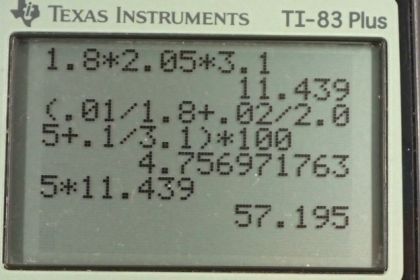Question
The sides of a small rectangular box are measured to be , long. Calculate its volume and uncertainty in cubic centimeters.
Final Answer
Solution video
OpenStax College Physics for AP® Courses, Chapter 1, Problem 25 (Problems & Exercises)

vote with a rating of
votes with an average rating of
.
Calculator Screenshots
Video Transcript
This is College Physics Answers with Shaun Dychko In this question, we consider a box with sides 1.80 plus or minus 0.01 centimeters, 2.05 plus or minus 0.02 centimeters and 3.1 plus or minus 0.1 centimeters, Let's suppose these are the length, width and height of the box and we have to calculate its volume and its uncertainty in that volume. So, volume is length times width times height. And so, we multiply these numbers together without thinking about their uncertainties because we'll think about the uncertainties in the next step after calculating the volume. So, we have 1.8 times 2.05 times 3.1 gives 11.439 cubic centimeters. Now, the percent uncertainty in the volume since we are multiplying these numbers together, the rule to find the percent uncertainty and the product of multiplying is that we take the percent uncertainties of each factor and add them together. So, we have percent uncertainty in the length plus percent uncertainty in the width plus percent uncertainty in the height, and I put a subscript there to the label, each of these percent uncertainties. And this is percent uncertainty in volume. And so, for the length, we have 0.1 centimeters divided by 1.80 centimeters and the percent certainty in the... width this .02 centimeters divided by 2.05 centimeters. Strictly speaking, this is the fractional uncertainty, not quite the percent uncertainty, but you know, the difference is this that we have to multiply it by 100% and after we're done, all this work here. That 100% is a common factor among all three terms here. So, I factored it out and just did it, the multiplication once at the end. And uncertainty in height is .1 centimeters divided by 3.1 and this works out to 4.757%. Now, I'm kind of of two minds here. On the one hand, I should not round this number because that would introduce intermediate rounding error because we're going to use this number in a subsequent calculation and normally, one would not round numbers because doing rounding as you go just compounds rounding and normally, there should be an unrounded number in the next calculation, but because it's an uncertainty, you can also think of it as... well, it's not very precise anyway. We're sure of that because it in and of itself is an expression of our guess of what the uncertainty is. And so, we could round it to just one significant figure and make it five. So, that's what I did here, but I think it would be quite fine to leave it as 4.757 in these next calculations as well. So, we're going to use this percent uncertainty to find the absolute uncertainty in the volume and that's going to be the percent certainty in the volume multiplied by the volume. And so, the 5%, we're going to write as 5 over 100 times 11.439 cubic centimeters that we calculated earlier here and that gives us a .57195 cubic centimeters which we will round to one significant figure here for sure because you know, now we're done, and uncertainties should only have one significant figure or maybe two. And so, that means with this being precise to the ones place, or sorry, precise to the tenths place, I should say. That means our volume is limited to precision of the tenths place as well. And so, we express our answer as volume is 11.4 plus or minus .6 cubic centimeters.

